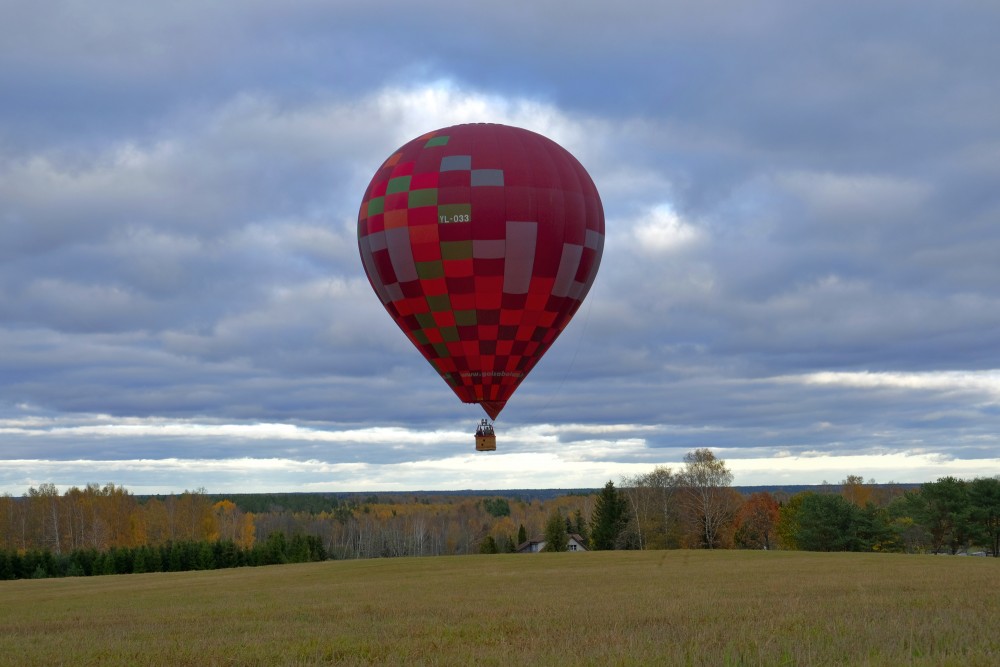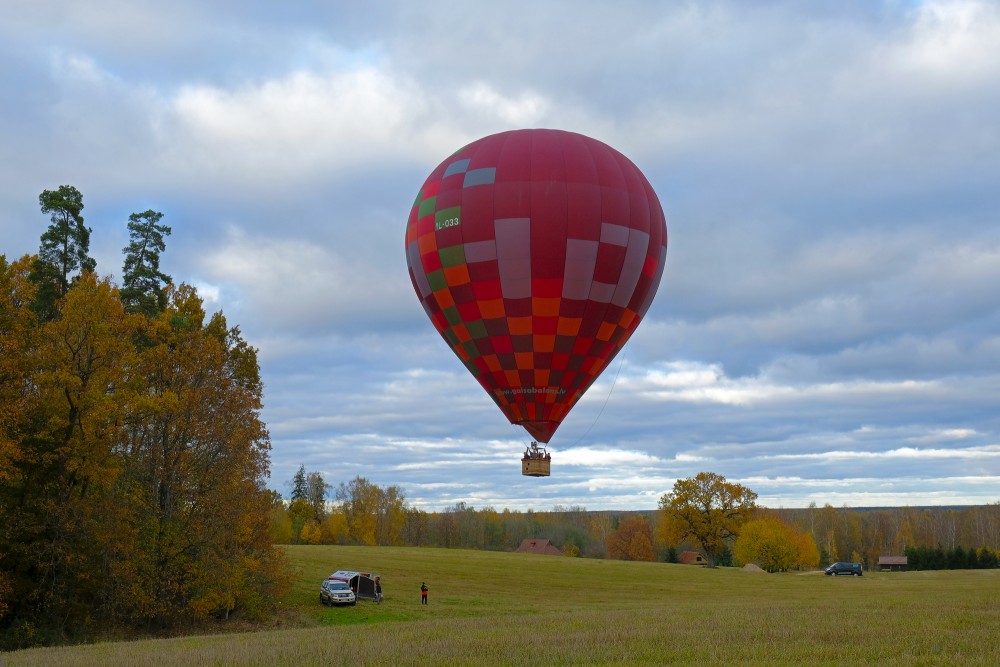Balloon (aeronautics)
In aeronautics, a balloon is an unpowered aerostat, which remains aloft or floats due to its buoyancy. A balloon may be free, moving with the wind, or tethered to a fixed point. It is distinct from an airship, which is a powered aerostat that can propel itself through the air in a controlled manner.
Many balloons have a basket, gondola, or capsule suspended beneath the main envelope for carrying people or equipment (including cameras and telescopes, and flight-control mechanisms).
Principles
A balloon is conceptually the simplest of all flying machines. The balloon is a fabric envelope filled with a gas that is lighter than the surrounding atmosphere. As the entire balloon is less dense than its surroundings, it rises, taking along with it a basket, attached underneath, which carries passengers or payload. Although a balloon has no propulsion system, a degree of directional control is possible through making the balloon rise or sink in altitude to find favorable wind directions.
There are three main types of balloon:
- The hot air balloon or Montgolfière obtains its buoyancy by heating the air inside the balloon; it has become the most common type.
- The gas balloon or Charlière is inflated with a gas of lower molecular weight than the ambient atmosphere; most gas balloons operate with the internal pressure of the gas the same as the pressure of the surrounding atmosphere; a superpressure balloon can operate with the lifting gas at pressure that exceeds that of the surrounding air, with the objective of limiting or eliminating the loss of gas from day-time heating; gas balloons are filled with gases such as:
- hydrogen – originally used extensively but, since the Hindenburg disaster, is now seldom used due to its high flammability;
- coal gas – although giving around half the lift of hydrogen, extensively used during the nineteenth and early twentieth century, since it was cheaper than hydrogen and readily available;
-helium – used today for all airships and most manned gas balloons;
-other gases have included ammonia and methane, but these have poor lifting capacity and other safety defects and have never been widely used.
- The Rozière type has both heated and unheated lifting gases in separate gasbags. This type of balloon is sometimes used for long-distance record flights, such as the recent circumnavigations, but is not otherwise in use.
Both the hot air, or Montgolfière, balloon and the gas balloon are still in common use. Montgolfière balloons are relatively inexpensive, as they do not require high-grade materials for their envelopes, and they are popular for balloonist sport activity.
Hot air balloons
The first balloon which carried passengers used hot air to obtain buoyancy and was built by the brothers Joseph and Etienne Montgolfier in Annonay, France in 1783: the first passenger flight was 19 September 1783, carrying a sheep, a duck, and a rooster.
The first tethered manned balloon flight was by a larger Montgolfier balloon, probably on 15 October 1783. The first free balloon flight was by the same Montgolfier balloon on 21 November 1783.
When heated, air expands, so a given volume of space contains less air. This makes it lighter and, if its lifting power is greater than the weight of the balloon containing it, it will lift the balloon upwards. A hot air balloon can only stay up while it has fuel for its burner, to keep the air hot enough.
The Montgolfiers' early hot air balloons used a solid-fuel brazier which proved less practical than the hydrogen balloons that had followed almost immediately, and hot air ballooning soon died out.
In the 1950s, the convenience and low cost of bottled gas burners led to a revival of hot air ballooning for sport and leisure.
The height or altitude of a hot air balloon is controlled by turning the burner up or down as needed, unlike a gas balloon where ballast weights are often carried so that they can be dropped if the balloon gets too low, and in order to land some lifting gas must be vented through a valve.
Gas balloons
A man-carrying balloon using the light gas hydrogen for buoyancy was made by Professor Jacques Charles and flown less than a month after the Montgolfier flight, on 1 December 1783. Gas balloons have greater lift for a given volume, so they do not need to be so large, and they can also stay up for much longer than hot air, so gas balloons dominated ballooning for the next 200 years. In the 19th century, it was common to use town gas to fill balloons; this was not as light as pure hydrogen gas, having about half the lifting power, but it was much cheaper and readily available.
Light gas balloons are predominant in scientific applications, as they are capable of reaching much higher altitudes for much longer periods of time. They are generally filled with helium. Although hydrogen has more lifting power, it is explosive in an atmosphere rich in oxygen. With a few exceptions, scientific balloon missions are unmanned.
There are two types of light-gas balloons: zero-pressure and superpressure. Zero-pressure balloons are the traditional form of light-gas balloon. They are partially inflated with the light gas before launch, with the gas pressure the same both inside and outside the balloon. As the zero-pressure balloon rises, its gas expands to maintain the zero pressure difference, and the balloon's envelope swells.
At night, the gas in a zero-pressure balloon cools and contracts, causing the balloon to sink. A zero-pressure balloon can only maintain altitude by releasing gas when it goes too high, where the expanding gas can threaten to rupture the envelope, or releasing ballast when it sinks too low. Loss of gas and ballast limits the endurance of zero-pressure balloons to a few days.
A superpressure balloon, in contrast, has a tough and inelastic envelope that is filled with light gas to pressure higher than that of the external atmosphere, and then sealed. The superpressure balloon cannot change size greatly, and so maintains a generally constant volume. The superpressure balloon maintains an altitude of constant density in the atmosphere, and can maintain flight until gas leakage gradually brings it down.
Superpressure balloons offer flight endurance of months, rather than days. In fact, in typical operation an Earth-based superpressure balloon mission is ended by a command from ground control to open the envelope, rather than by natural leakage of gas.
High-altitude balloons are used as high flying vessels to carry scientific instruments (like weather balloons), or reach near-space altitudes to take footage or photos of the earth. These balloons can fly over 100,000 feet (30.5 km) into the air, and are designed to burst at a set altitude where the parachute will deploy to safely carry the payload back to earth.
Cluster ballooning uses many smaller gas-filled balloons for flight (see An Introduction to Cluster Ballooning).
Combination balloons
Early hot air balloons could not stay up for very long because they used a lot of fuel, while early hydrogen balloons were difficult to take higher or lower as desired because the aeronaut could only vent the gas or drop off ballast a limited number of times. Pilâtre de Rozier realised that for a long-distance flight such as crossing the English Channel, the aeronaut would need to make use of the differing wind directions at different altitudes. It would be essential therefore to have good control of altitude while still able to stay up for a long time. He developed a combination balloon having two gas bags, the Rozier balloon. The upper one held hydrogen and provided most of the steady lift. The lower one held hot air and could be quickly heated or cooled to provide the varying lift for good altitude control.
In 1785 Pilâtre de Rozier took off in an attempt to fly across the Channel, but shortly into the flight the hydrogen gas bag caught fire and de Rozier did not survive the ensuing accident. This earned de Rozier the title "The First to Fly and the First to Die".
It wasn't until the 1980s that technology was developed to allow safe operation of the Rozier type, for example by using non-flammable helium as the lifting gas, and several designs have successfully undertaken long-distance flights.
Tethering and kite balloons
As an alternative to free flight, a balloon may be tethered to allow reliable take off and landing at the same location. Some of the earliest balloon flights were tethered for safety, and since then balloons have been tethered for many purposes, including military observation and aerial barrage, meteorological and commercial uses.
The natural spherical shape of a balloon is unstable in high winds. Tethered balloons for use in windy conditions are often stabilised by aerodynamic shaping and connecting to the tether by a halter arrangement. These are called kite balloons.
A kite balloon is distinct from a kytoon, which obtains a portion of its lift aerodynamically.
en.wikipedia.org






